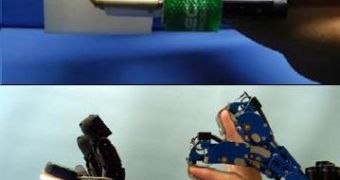Wouldn't it be good when another pulls your chestnuts out of the fire? Or at least a machine...
This is what haptic technology deals with: the sense of touch, with an array of applications, from telesurgery and robotic remote control to improved immersive computer games. Haptic devices are now just simple "rumble pack" games controllers and force-feedback devices like the Phantom Desktop, a graspable pen on the tip of a motorized robotic arm.
A team led by Susumu Tachi at the University of Tokyo, Japan, developed the Gravity Grabber, an improved technology stimulating touch and employing a simple set up of motors and belts: two tube-shaped attachments that match a person's thumb and forefinger.
Each tube has two motors on top connecting it to a belt around the tip of the finger. The motors moves the belt inducing the feeling of touching an object or holding something heavy by pulling more tightly.
"Something as simple and low-cost as the Gravity Grabber could be ideally suited to gaming," said co-author Kouta Minamizawa.
The same team developed an even more sensitive haptic device for remote manipulation, named Haptic Telexistence, made of a large mechanical controller put on an user's hand and connecting him/her to a remote robotic "slave" hand.
Each fingertip on the robotic hand has LEDs with a small camera behind and the level of reflected light from an object shows its shape and the degree of holding. A similar force is then sent to the user's fingertips through an array of tiny pegs that pop up and release a minuscule electric current to stimulate nerve fibers.
"This "electro-tactile feedback" is more subtle than alternative techniques such as vibration. This can deliver a sensation a texture and even, in principle, heat," said co-researcher Katsunari Sato.
Farzam Farbiz at the Agency for Science, Technology and Research in Singapore is working on a project involving the stimulation of the forearm muscles with electricity to deliver the sensation of hitting a tennis ball. By tuning the frequency and amplitude of signals sent by electrodes to the arm, his device imitates the muscle contractions of a real contact with the ball. "The sensations are not yet fully realistic," admitted Farbiz, who is working on improving the device.
A very delicate artificial touch sensor is the Fibratus Tactile Sensor, developed by a team led by Satoshi Saga at Tohoku University in Japan. It is made of feathers embedded in a silicone gel mounted in a specific pattern and with a video camera beneath. The movement of the feathers in the gel shifts the filtered light, a change detected by the camera. A computer determines the pressure exerted on the feathers.
"This might ultimately be used to give robots a more human-like ability to touch and feel." said Saga.

 14 DAY TRIAL //
14 DAY TRIAL //